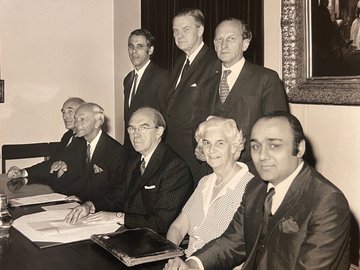
Ugandan Resettlement Board
‐
A government-appointed organization to assist South Asian expellees from Uganda on their arrival in the United Kingdom
Location(s)
Nationwide
About
Up until the 1960s and 1970s, large communities of South Asians were settled in East Africa – namely in Kenya, Tanzania and Uganda. Following independence in these East African countries, many settled in the UK, experiencing multiple migrations. South Asians in Kenya and Tanzania resettled due to political upheaval and uncertainty; however, in Uganda the communities from the subcontinent not only experienced these disruptions but were abruptly expelled by the dictator Idi Amin on 14 August 1972. Accused of non-integration and sabotaging the Ugandan economy, the diaspora in Uganda were given ninety days to leave their homes and resettle elsewhere. Exercising their British nationality, many of these South Asians came to the UK.
The Ugandan Resettlement Board, directed by T. A. Critchley, was tasked with receiving the twice migrants from Uganda and assisting with resettlement. The Board’s duties and powers were detailed in a Trust Deed between the Home Secretary, members of the Board and the Lords Commissioners of Her Majesty's Treasury. The Deed of Trust was modelled on a similar deed used for the Anglo-Egyptian Resettlement Board in 1956. Praful Patel was the only South Asian member of the Board.
The Board described their work as divided into four categories: (1) meeting arrivals and providing immediate counsel; (2) organizing resettlement centres (often known as refugee camps) as temporary accommodation for those families who were unable to make their own arrangements; (3) providing help and advice, including on housing; (4) offering in-community support for the process of resettlement.
Resettlement centres numbered sixteen in total, through which temporary accommodation, food, education, health and other services were offered to around 22,000 people. Camps were located in Kensington, Stradishall, Hemswell, Houndstone, Greenham Common, West Malling, Tonfanau, Heathfield, Faldingworth, Lingfield, Plasterdown, Maresfield, Piddlehinton, Doniford, Raleigh Hall and Gaydon. The first arrivals landed on 18 September 1972. On 15 January 1974 the final centre, in West Malling, was closed, marking the point by which all families had been moved to other accommodation. It is calculated that the total spend by the Board to support its activities was £6.1 million.
The arrival of South Asians from Uganda was met with some opposition. For example, on 24 August 1972 there was a demonstration by the Smithfield porters, organized by the National Front, against the arrival of the Ugandan Asians. Concerns included how migrant resettlement in certain areas might result in pressure upon local resources and services. To counter concentrated pockets of resettlement, the Board’s policy was to disperse arrivals throughout the country. This policy was met with some controversy, as certain regions in the UK were declared ‘red’ zones whilst others were ‘green’ zones. Ugandan Asians were steered away from red areas – the Board providing no assistance to these areas – whilst ‘green’ areas were promoted and assistance provided.
T. A. Critchley, Praful Patel.
The Asians from Uganda Forum, http://www.asiansfromuganda.org.uk/uganda_resettlement_board.php
BA 25/516, Public Records Office, National Archives, Kew, UK
HO 289/29, Public Records Office, National Archives, Kew, UK
For image and copyright details, please click "More Information" in the Viewer.
Image credit
With thanks to Alan Critchley
Image includes members: TA Critchley (Director URB), Sir Charles Cunningham (Chair URB), Mrs Frances Clode, CBE, Praful Patel.
